9B17M033 Netflix in India The Way Ahead - Desklib
VerifiedAdded on 2020/04/15
|11
|3279
|376
AI Summary
Contribute Materials
Your contribution can guide someone’s learning journey. Share your
documents today.
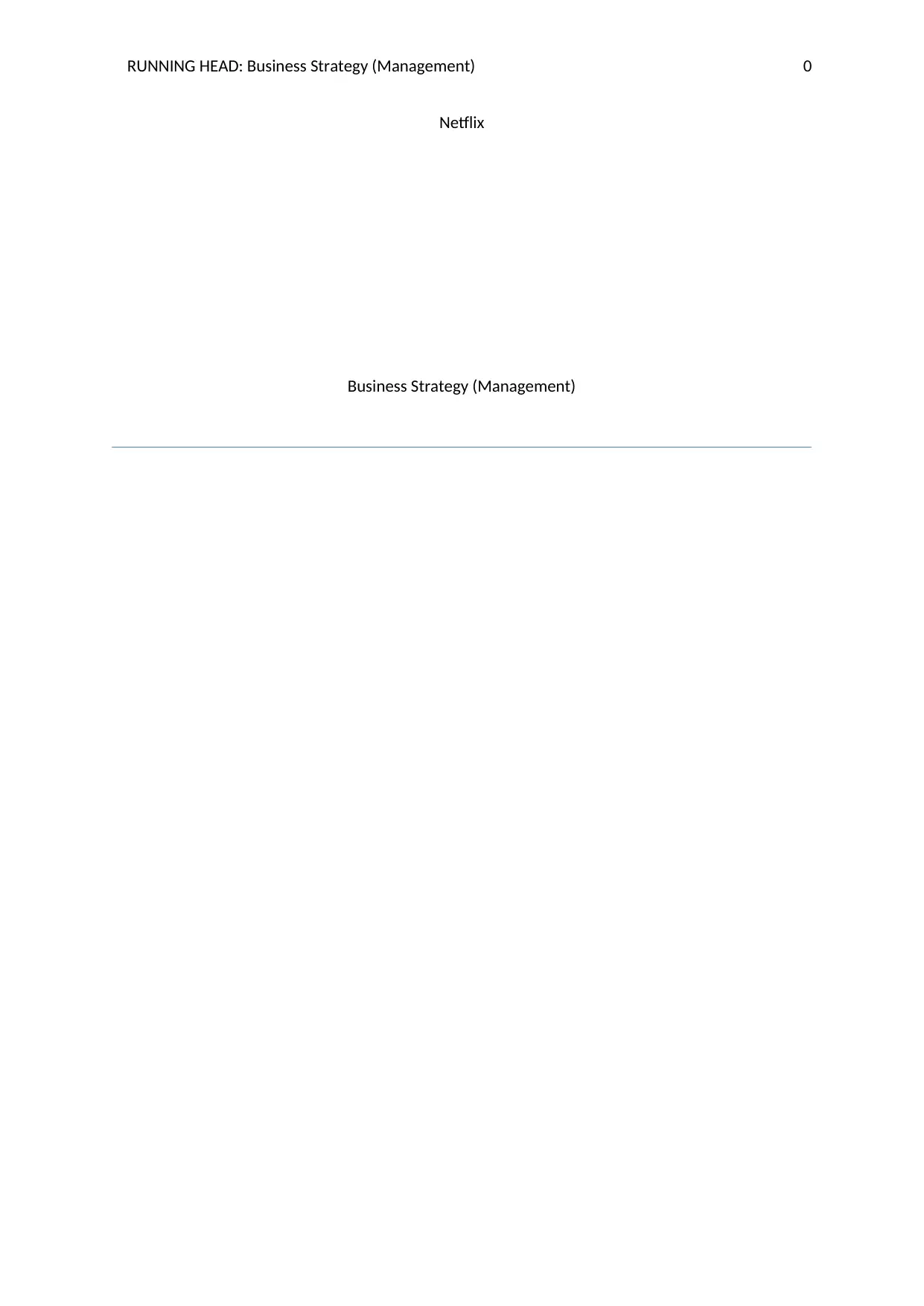
RUNNING HEAD: Business Strategy (Management) 0
Netflix
Business Strategy (Management)
Netflix
Business Strategy (Management)
Secure Best Marks with AI Grader
Need help grading? Try our AI Grader for instant feedback on your assignments.

Business Strategy (Management) 1
Table of Contents
Netflix........................................................................................................................................2
Resources & capabilities............................................................................................................2
Core competencies.....................................................................................................................4
Competitive advantage...............................................................................................................6
Conclusion..................................................................................................................................8
References................................................................................................................................10
Table of Contents
Netflix........................................................................................................................................2
Resources & capabilities............................................................................................................2
Core competencies.....................................................................................................................4
Competitive advantage...............................................................................................................6
Conclusion..................................................................................................................................8
References................................................................................................................................10
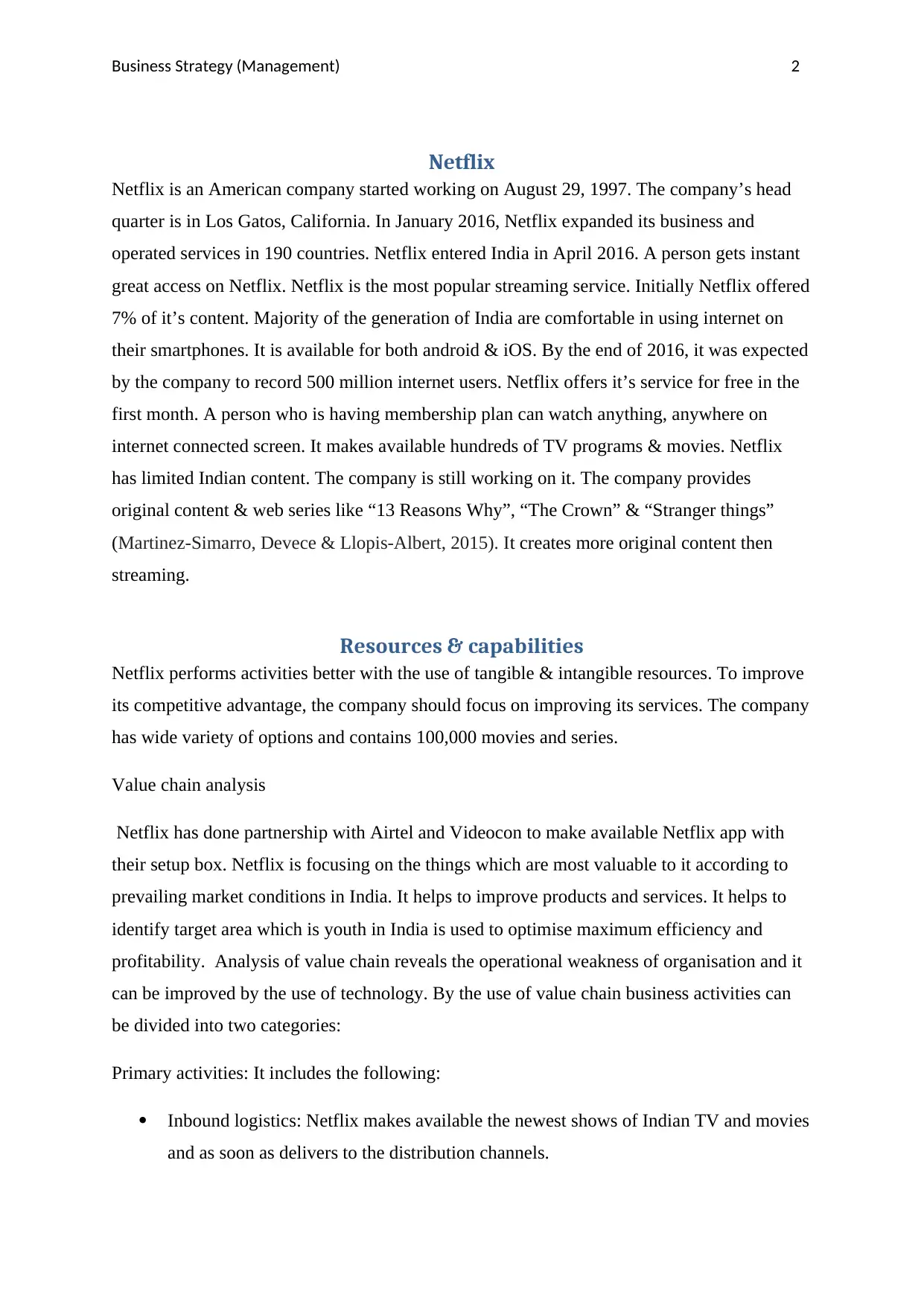
Business Strategy (Management) 2
Netflix
Netflix is an American company started working on August 29, 1997. The company’s head
quarter is in Los Gatos, California. In January 2016, Netflix expanded its business and
operated services in 190 countries. Netflix entered India in April 2016. A person gets instant
great access on Netflix. Netflix is the most popular streaming service. Initially Netflix offered
7% of it’s content. Majority of the generation of India are comfortable in using internet on
their smartphones. It is available for both android & iOS. By the end of 2016, it was expected
by the company to record 500 million internet users. Netflix offers it’s service for free in the
first month. A person who is having membership plan can watch anything, anywhere on
internet connected screen. It makes available hundreds of TV programs & movies. Netflix
has limited Indian content. The company is still working on it. The company provides
original content & web series like “13 Reasons Why”, “The Crown” & “Stranger things”
(Martinez-Simarro, Devece & Llopis-Albert, 2015). It creates more original content then
streaming.
Resources & capabilities
Netflix performs activities better with the use of tangible & intangible resources. To improve
its competitive advantage, the company should focus on improving its services. The company
has wide variety of options and contains 100,000 movies and series.
Value chain analysis
Netflix has done partnership with Airtel and Videocon to make available Netflix app with
their setup box. Netflix is focusing on the things which are most valuable to it according to
prevailing market conditions in India. It helps to improve products and services. It helps to
identify target area which is youth in India is used to optimise maximum efficiency and
profitability. Analysis of value chain reveals the operational weakness of organisation and it
can be improved by the use of technology. By the use of value chain business activities can
be divided into two categories:
Primary activities: It includes the following:
Inbound logistics: Netflix makes available the newest shows of Indian TV and movies
and as soon as delivers to the distribution channels.
Netflix
Netflix is an American company started working on August 29, 1997. The company’s head
quarter is in Los Gatos, California. In January 2016, Netflix expanded its business and
operated services in 190 countries. Netflix entered India in April 2016. A person gets instant
great access on Netflix. Netflix is the most popular streaming service. Initially Netflix offered
7% of it’s content. Majority of the generation of India are comfortable in using internet on
their smartphones. It is available for both android & iOS. By the end of 2016, it was expected
by the company to record 500 million internet users. Netflix offers it’s service for free in the
first month. A person who is having membership plan can watch anything, anywhere on
internet connected screen. It makes available hundreds of TV programs & movies. Netflix
has limited Indian content. The company is still working on it. The company provides
original content & web series like “13 Reasons Why”, “The Crown” & “Stranger things”
(Martinez-Simarro, Devece & Llopis-Albert, 2015). It creates more original content then
streaming.
Resources & capabilities
Netflix performs activities better with the use of tangible & intangible resources. To improve
its competitive advantage, the company should focus on improving its services. The company
has wide variety of options and contains 100,000 movies and series.
Value chain analysis
Netflix has done partnership with Airtel and Videocon to make available Netflix app with
their setup box. Netflix is focusing on the things which are most valuable to it according to
prevailing market conditions in India. It helps to improve products and services. It helps to
identify target area which is youth in India is used to optimise maximum efficiency and
profitability. Analysis of value chain reveals the operational weakness of organisation and it
can be improved by the use of technology. By the use of value chain business activities can
be divided into two categories:
Primary activities: It includes the following:
Inbound logistics: Netflix makes available the newest shows of Indian TV and movies
and as soon as delivers to the distribution channels.
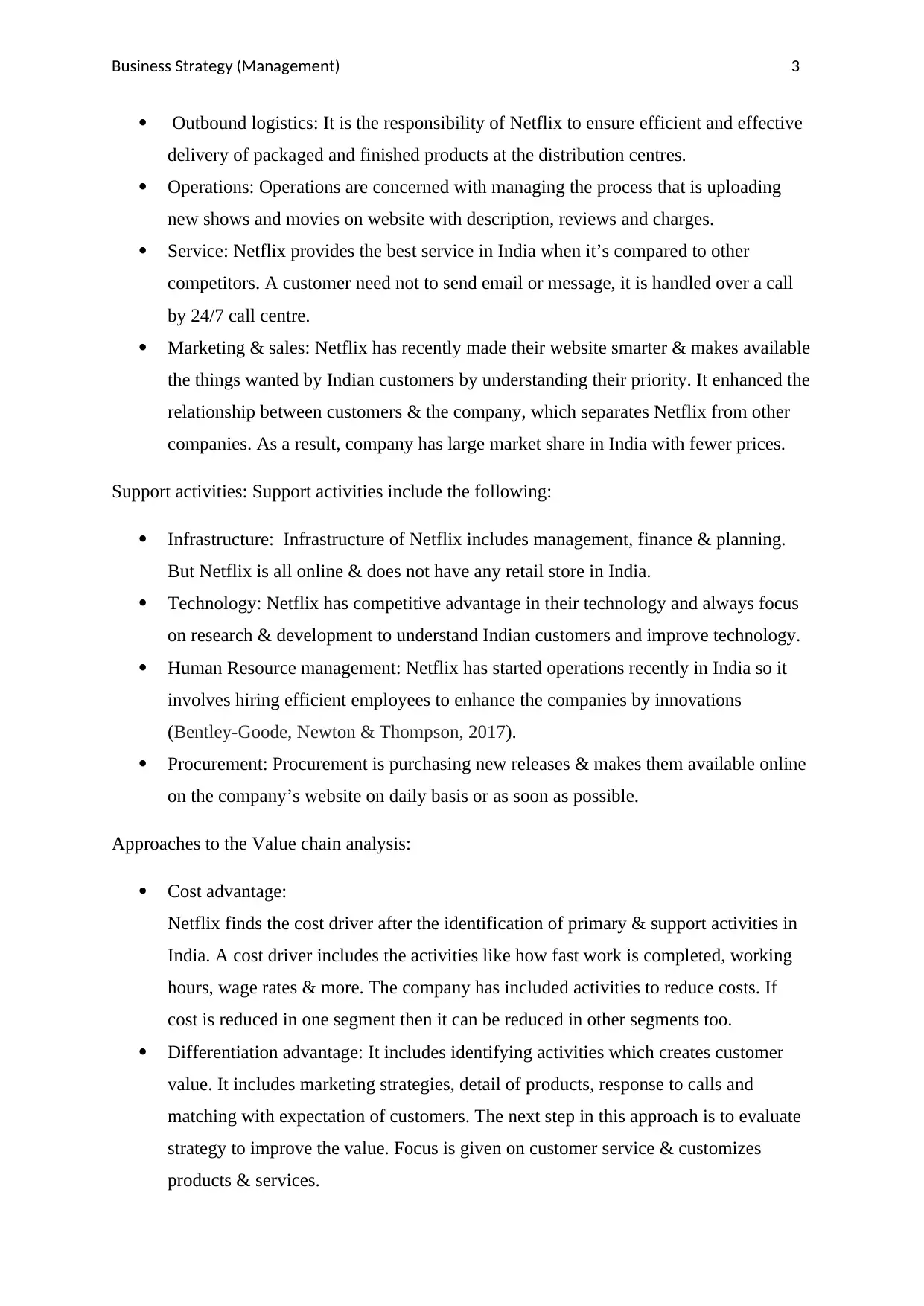
Business Strategy (Management) 3
Outbound logistics: It is the responsibility of Netflix to ensure efficient and effective
delivery of packaged and finished products at the distribution centres.
Operations: Operations are concerned with managing the process that is uploading
new shows and movies on website with description, reviews and charges.
Service: Netflix provides the best service in India when it’s compared to other
competitors. A customer need not to send email or message, it is handled over a call
by 24/7 call centre.
Marketing & sales: Netflix has recently made their website smarter & makes available
the things wanted by Indian customers by understanding their priority. It enhanced the
relationship between customers & the company, which separates Netflix from other
companies. As a result, company has large market share in India with fewer prices.
Support activities: Support activities include the following:
Infrastructure: Infrastructure of Netflix includes management, finance & planning.
But Netflix is all online & does not have any retail store in India.
Technology: Netflix has competitive advantage in their technology and always focus
on research & development to understand Indian customers and improve technology.
Human Resource management: Netflix has started operations recently in India so it
involves hiring efficient employees to enhance the companies by innovations
(Bentley-Goode, Newton & Thompson, 2017).
Procurement: Procurement is purchasing new releases & makes them available online
on the company’s website on daily basis or as soon as possible.
Approaches to the Value chain analysis:
Cost advantage:
Netflix finds the cost driver after the identification of primary & support activities in
India. A cost driver includes the activities like how fast work is completed, working
hours, wage rates & more. The company has included activities to reduce costs. If
cost is reduced in one segment then it can be reduced in other segments too.
Differentiation advantage: It includes identifying activities which creates customer
value. It includes marketing strategies, detail of products, response to calls and
matching with expectation of customers. The next step in this approach is to evaluate
strategy to improve the value. Focus is given on customer service & customizes
products & services.
Outbound logistics: It is the responsibility of Netflix to ensure efficient and effective
delivery of packaged and finished products at the distribution centres.
Operations: Operations are concerned with managing the process that is uploading
new shows and movies on website with description, reviews and charges.
Service: Netflix provides the best service in India when it’s compared to other
competitors. A customer need not to send email or message, it is handled over a call
by 24/7 call centre.
Marketing & sales: Netflix has recently made their website smarter & makes available
the things wanted by Indian customers by understanding their priority. It enhanced the
relationship between customers & the company, which separates Netflix from other
companies. As a result, company has large market share in India with fewer prices.
Support activities: Support activities include the following:
Infrastructure: Infrastructure of Netflix includes management, finance & planning.
But Netflix is all online & does not have any retail store in India.
Technology: Netflix has competitive advantage in their technology and always focus
on research & development to understand Indian customers and improve technology.
Human Resource management: Netflix has started operations recently in India so it
involves hiring efficient employees to enhance the companies by innovations
(Bentley-Goode, Newton & Thompson, 2017).
Procurement: Procurement is purchasing new releases & makes them available online
on the company’s website on daily basis or as soon as possible.
Approaches to the Value chain analysis:
Cost advantage:
Netflix finds the cost driver after the identification of primary & support activities in
India. A cost driver includes the activities like how fast work is completed, working
hours, wage rates & more. The company has included activities to reduce costs. If
cost is reduced in one segment then it can be reduced in other segments too.
Differentiation advantage: It includes identifying activities which creates customer
value. It includes marketing strategies, detail of products, response to calls and
matching with expectation of customers. The next step in this approach is to evaluate
strategy to improve the value. Focus is given on customer service & customizes
products & services.
Secure Best Marks with AI Grader
Need help grading? Try our AI Grader for instant feedback on your assignments.
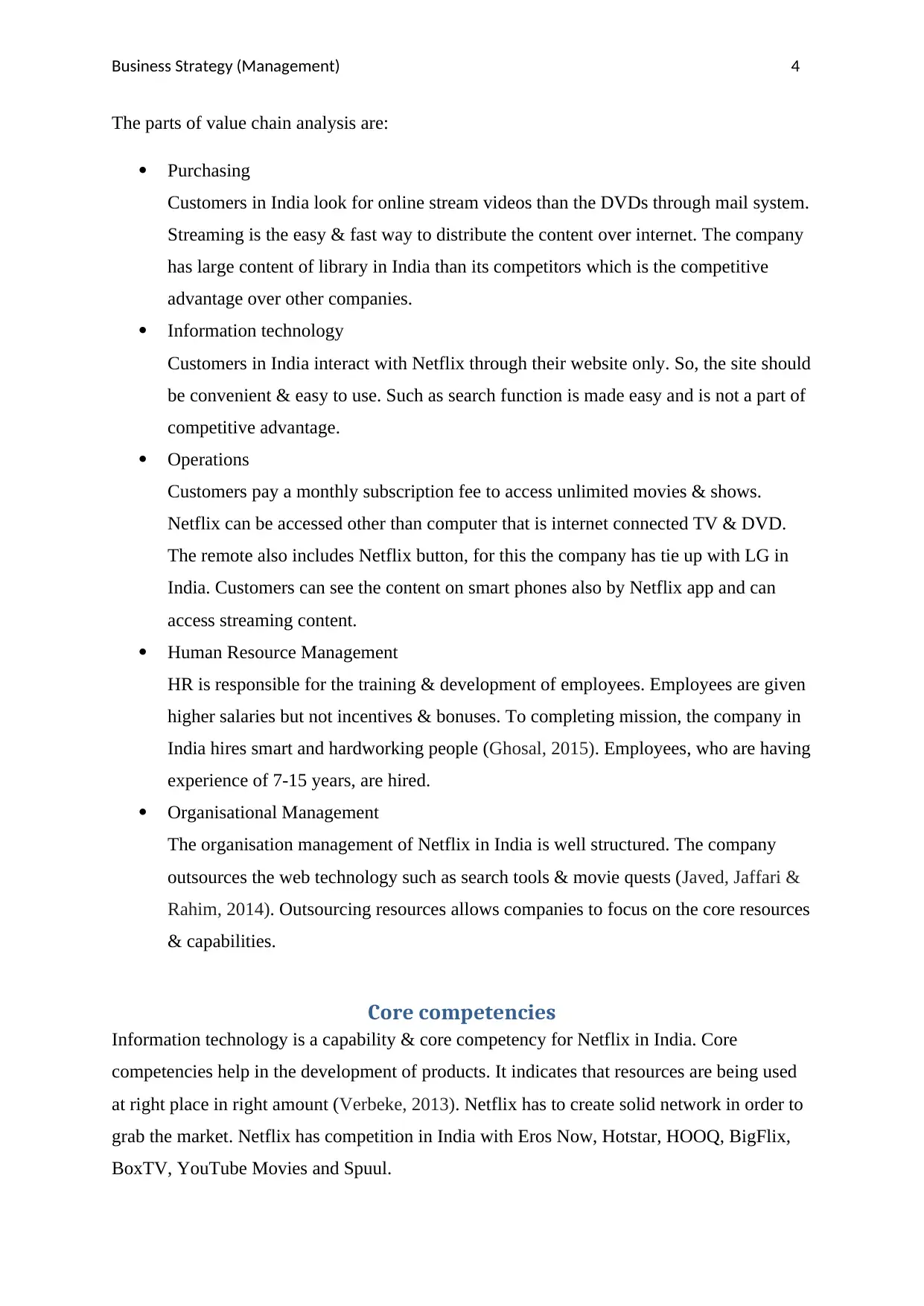
Business Strategy (Management) 4
The parts of value chain analysis are:
Purchasing
Customers in India look for online stream videos than the DVDs through mail system.
Streaming is the easy & fast way to distribute the content over internet. The company
has large content of library in India than its competitors which is the competitive
advantage over other companies.
Information technology
Customers in India interact with Netflix through their website only. So, the site should
be convenient & easy to use. Such as search function is made easy and is not a part of
competitive advantage.
Operations
Customers pay a monthly subscription fee to access unlimited movies & shows.
Netflix can be accessed other than computer that is internet connected TV & DVD.
The remote also includes Netflix button, for this the company has tie up with LG in
India. Customers can see the content on smart phones also by Netflix app and can
access streaming content.
Human Resource Management
HR is responsible for the training & development of employees. Employees are given
higher salaries but not incentives & bonuses. To completing mission, the company in
India hires smart and hardworking people (Ghosal, 2015). Employees, who are having
experience of 7-15 years, are hired.
Organisational Management
The organisation management of Netflix in India is well structured. The company
outsources the web technology such as search tools & movie quests (Javed, Jaffari &
Rahim, 2014). Outsourcing resources allows companies to focus on the core resources
& capabilities.
Core competencies
Information technology is a capability & core competency for Netflix in India. Core
competencies help in the development of products. It indicates that resources are being used
at right place in right amount (Verbeke, 2013). Netflix has to create solid network in order to
grab the market. Netflix has competition in India with Eros Now, Hotstar, HOOQ, BigFlix,
BoxTV, YouTube Movies and Spuul.
The parts of value chain analysis are:
Purchasing
Customers in India look for online stream videos than the DVDs through mail system.
Streaming is the easy & fast way to distribute the content over internet. The company
has large content of library in India than its competitors which is the competitive
advantage over other companies.
Information technology
Customers in India interact with Netflix through their website only. So, the site should
be convenient & easy to use. Such as search function is made easy and is not a part of
competitive advantage.
Operations
Customers pay a monthly subscription fee to access unlimited movies & shows.
Netflix can be accessed other than computer that is internet connected TV & DVD.
The remote also includes Netflix button, for this the company has tie up with LG in
India. Customers can see the content on smart phones also by Netflix app and can
access streaming content.
Human Resource Management
HR is responsible for the training & development of employees. Employees are given
higher salaries but not incentives & bonuses. To completing mission, the company in
India hires smart and hardworking people (Ghosal, 2015). Employees, who are having
experience of 7-15 years, are hired.
Organisational Management
The organisation management of Netflix in India is well structured. The company
outsources the web technology such as search tools & movie quests (Javed, Jaffari &
Rahim, 2014). Outsourcing resources allows companies to focus on the core resources
& capabilities.
Core competencies
Information technology is a capability & core competency for Netflix in India. Core
competencies help in the development of products. It indicates that resources are being used
at right place in right amount (Verbeke, 2013). Netflix has to create solid network in order to
grab the market. Netflix has competition in India with Eros Now, Hotstar, HOOQ, BigFlix,
BoxTV, YouTube Movies and Spuul.
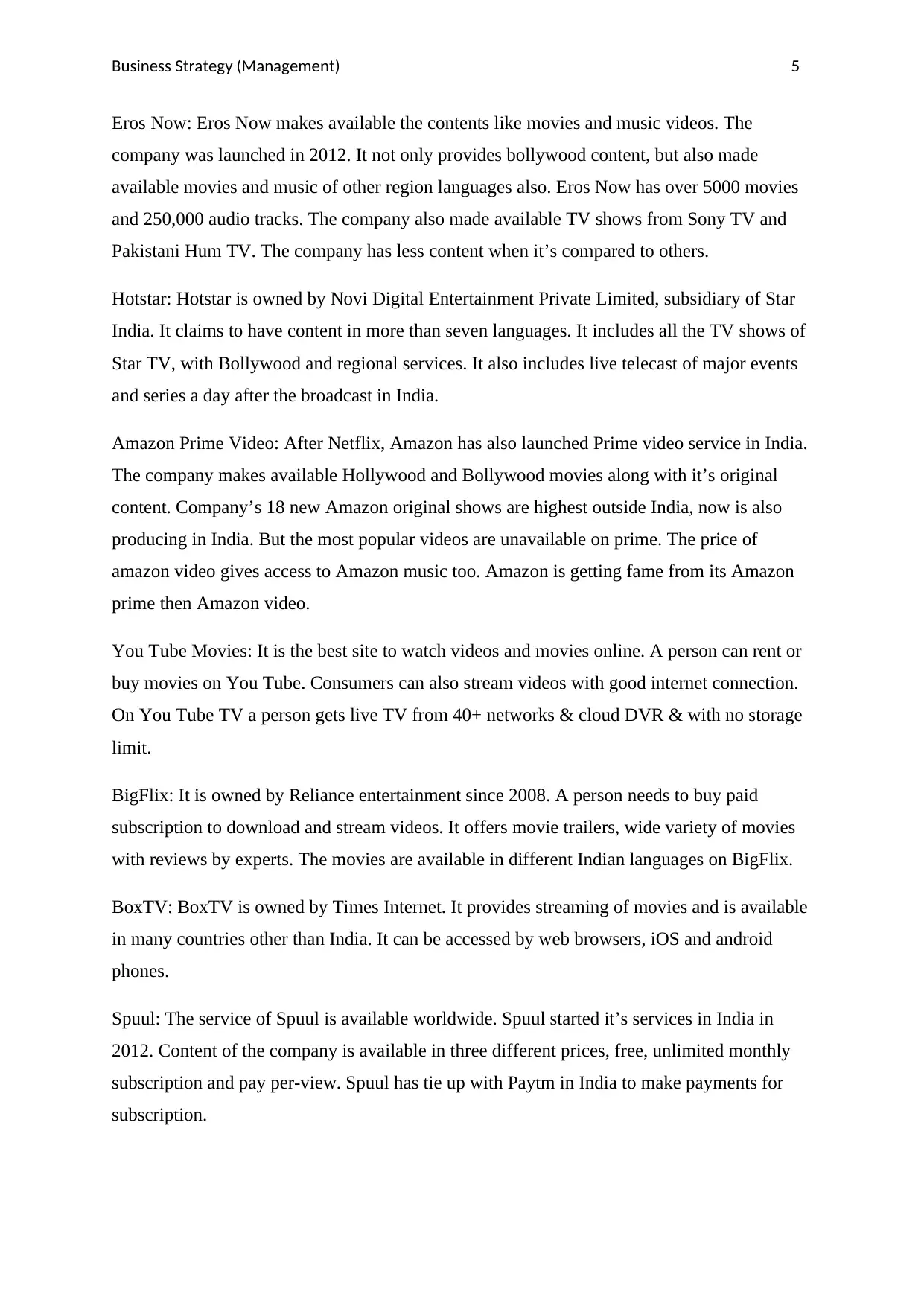
Business Strategy (Management) 5
Eros Now: Eros Now makes available the contents like movies and music videos. The
company was launched in 2012. It not only provides bollywood content, but also made
available movies and music of other region languages also. Eros Now has over 5000 movies
and 250,000 audio tracks. The company also made available TV shows from Sony TV and
Pakistani Hum TV. The company has less content when it’s compared to others.
Hotstar: Hotstar is owned by Novi Digital Entertainment Private Limited, subsidiary of Star
India. It claims to have content in more than seven languages. It includes all the TV shows of
Star TV, with Bollywood and regional services. It also includes live telecast of major events
and series a day after the broadcast in India.
Amazon Prime Video: After Netflix, Amazon has also launched Prime video service in India.
The company makes available Hollywood and Bollywood movies along with it’s original
content. Company’s 18 new Amazon original shows are highest outside India, now is also
producing in India. But the most popular videos are unavailable on prime. The price of
amazon video gives access to Amazon music too. Amazon is getting fame from its Amazon
prime then Amazon video.
You Tube Movies: It is the best site to watch videos and movies online. A person can rent or
buy movies on You Tube. Consumers can also stream videos with good internet connection.
On You Tube TV a person gets live TV from 40+ networks & cloud DVR & with no storage
limit.
BigFlix: It is owned by Reliance entertainment since 2008. A person needs to buy paid
subscription to download and stream videos. It offers movie trailers, wide variety of movies
with reviews by experts. The movies are available in different Indian languages on BigFlix.
BoxTV: BoxTV is owned by Times Internet. It provides streaming of movies and is available
in many countries other than India. It can be accessed by web browsers, iOS and android
phones.
Spuul: The service of Spuul is available worldwide. Spuul started it’s services in India in
2012. Content of the company is available in three different prices, free, unlimited monthly
subscription and pay per-view. Spuul has tie up with Paytm in India to make payments for
subscription.
Eros Now: Eros Now makes available the contents like movies and music videos. The
company was launched in 2012. It not only provides bollywood content, but also made
available movies and music of other region languages also. Eros Now has over 5000 movies
and 250,000 audio tracks. The company also made available TV shows from Sony TV and
Pakistani Hum TV. The company has less content when it’s compared to others.
Hotstar: Hotstar is owned by Novi Digital Entertainment Private Limited, subsidiary of Star
India. It claims to have content in more than seven languages. It includes all the TV shows of
Star TV, with Bollywood and regional services. It also includes live telecast of major events
and series a day after the broadcast in India.
Amazon Prime Video: After Netflix, Amazon has also launched Prime video service in India.
The company makes available Hollywood and Bollywood movies along with it’s original
content. Company’s 18 new Amazon original shows are highest outside India, now is also
producing in India. But the most popular videos are unavailable on prime. The price of
amazon video gives access to Amazon music too. Amazon is getting fame from its Amazon
prime then Amazon video.
You Tube Movies: It is the best site to watch videos and movies online. A person can rent or
buy movies on You Tube. Consumers can also stream videos with good internet connection.
On You Tube TV a person gets live TV from 40+ networks & cloud DVR & with no storage
limit.
BigFlix: It is owned by Reliance entertainment since 2008. A person needs to buy paid
subscription to download and stream videos. It offers movie trailers, wide variety of movies
with reviews by experts. The movies are available in different Indian languages on BigFlix.
BoxTV: BoxTV is owned by Times Internet. It provides streaming of movies and is available
in many countries other than India. It can be accessed by web browsers, iOS and android
phones.
Spuul: The service of Spuul is available worldwide. Spuul started it’s services in India in
2012. Content of the company is available in three different prices, free, unlimited monthly
subscription and pay per-view. Spuul has tie up with Paytm in India to make payments for
subscription.
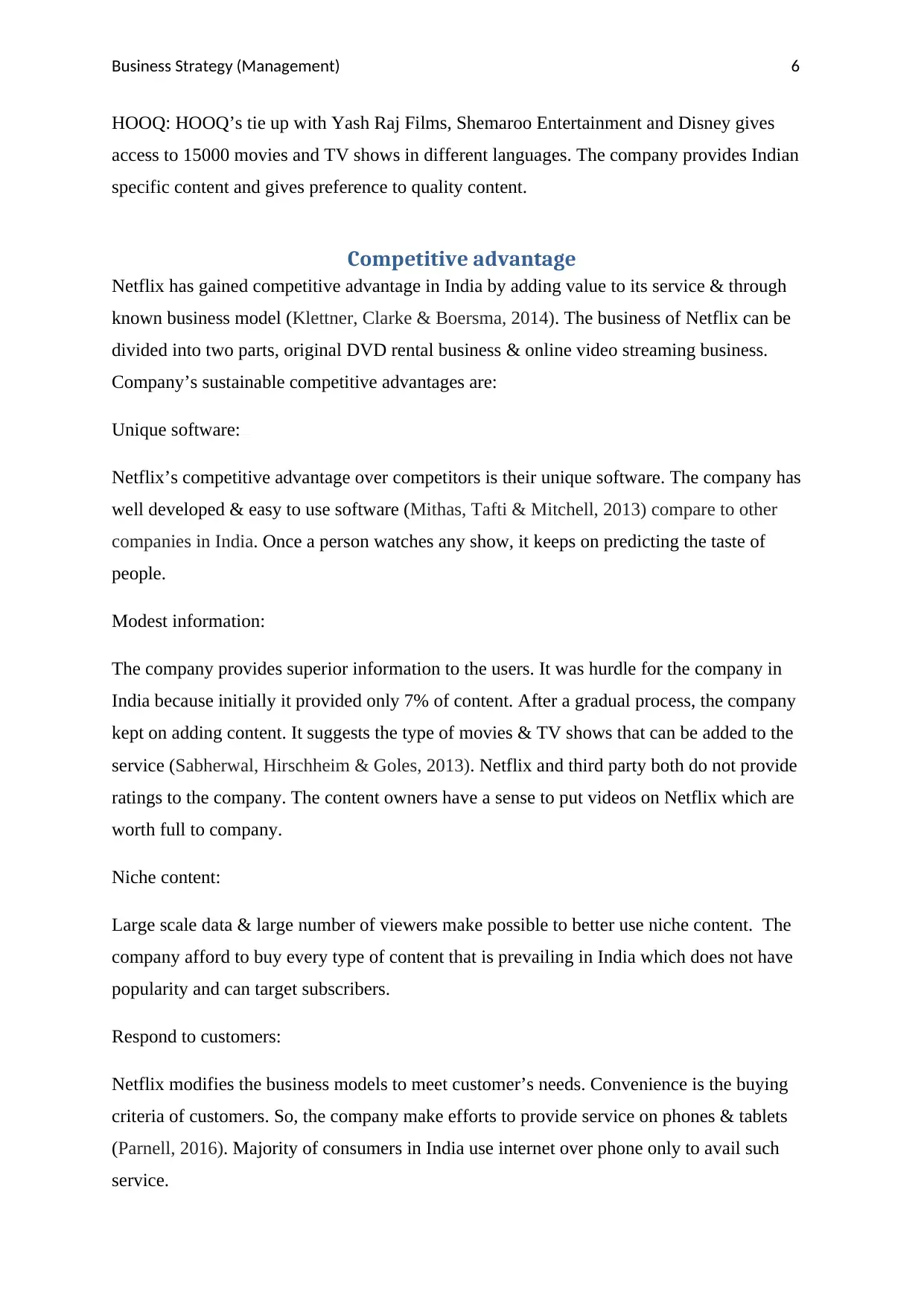
Business Strategy (Management) 6
HOOQ: HOOQ’s tie up with Yash Raj Films, Shemaroo Entertainment and Disney gives
access to 15000 movies and TV shows in different languages. The company provides Indian
specific content and gives preference to quality content.
Competitive advantage
Netflix has gained competitive advantage in India by adding value to its service & through
known business model (Klettner, Clarke & Boersma, 2014). The business of Netflix can be
divided into two parts, original DVD rental business & online video streaming business.
Company’s sustainable competitive advantages are:
Unique software:
Netflix’s competitive advantage over competitors is their unique software. The company has
well developed & easy to use software (Mithas, Tafti & Mitchell, 2013) compare to other
companies in India. Once a person watches any show, it keeps on predicting the taste of
people.
Modest information:
The company provides superior information to the users. It was hurdle for the company in
India because initially it provided only 7% of content. After a gradual process, the company
kept on adding content. It suggests the type of movies & TV shows that can be added to the
service (Sabherwal, Hirschheim & Goles, 2013). Netflix and third party both do not provide
ratings to the company. The content owners have a sense to put videos on Netflix which are
worth full to company.
Niche content:
Large scale data & large number of viewers make possible to better use niche content. The
company afford to buy every type of content that is prevailing in India which does not have
popularity and can target subscribers.
Respond to customers:
Netflix modifies the business models to meet customer’s needs. Convenience is the buying
criteria of customers. So, the company make efforts to provide service on phones & tablets
(Parnell, 2016). Majority of consumers in India use internet over phone only to avail such
service.
HOOQ: HOOQ’s tie up with Yash Raj Films, Shemaroo Entertainment and Disney gives
access to 15000 movies and TV shows in different languages. The company provides Indian
specific content and gives preference to quality content.
Competitive advantage
Netflix has gained competitive advantage in India by adding value to its service & through
known business model (Klettner, Clarke & Boersma, 2014). The business of Netflix can be
divided into two parts, original DVD rental business & online video streaming business.
Company’s sustainable competitive advantages are:
Unique software:
Netflix’s competitive advantage over competitors is their unique software. The company has
well developed & easy to use software (Mithas, Tafti & Mitchell, 2013) compare to other
companies in India. Once a person watches any show, it keeps on predicting the taste of
people.
Modest information:
The company provides superior information to the users. It was hurdle for the company in
India because initially it provided only 7% of content. After a gradual process, the company
kept on adding content. It suggests the type of movies & TV shows that can be added to the
service (Sabherwal, Hirschheim & Goles, 2013). Netflix and third party both do not provide
ratings to the company. The content owners have a sense to put videos on Netflix which are
worth full to company.
Niche content:
Large scale data & large number of viewers make possible to better use niche content. The
company afford to buy every type of content that is prevailing in India which does not have
popularity and can target subscribers.
Respond to customers:
Netflix modifies the business models to meet customer’s needs. Convenience is the buying
criteria of customers. So, the company make efforts to provide service on phones & tablets
(Parnell, 2016). Majority of consumers in India use internet over phone only to avail such
service.
Paraphrase This Document
Need a fresh take? Get an instant paraphrase of this document with our AI Paraphraser
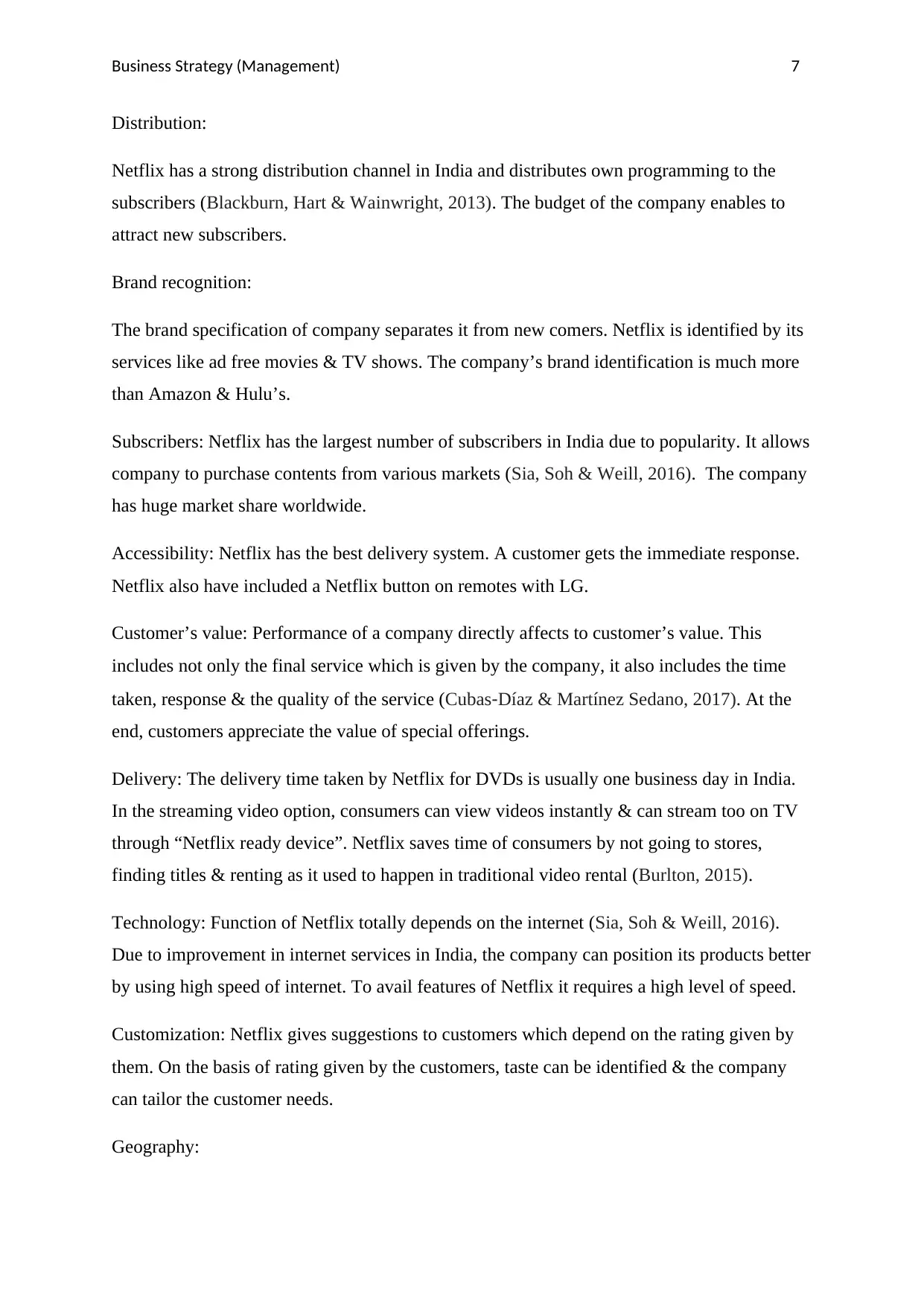
Business Strategy (Management) 7
Distribution:
Netflix has a strong distribution channel in India and distributes own programming to the
subscribers (Blackburn, Hart & Wainwright, 2013). The budget of the company enables to
attract new subscribers.
Brand recognition:
The brand specification of company separates it from new comers. Netflix is identified by its
services like ad free movies & TV shows. The company’s brand identification is much more
than Amazon & Hulu’s.
Subscribers: Netflix has the largest number of subscribers in India due to popularity. It allows
company to purchase contents from various markets (Sia, Soh & Weill, 2016). The company
has huge market share worldwide.
Accessibility: Netflix has the best delivery system. A customer gets the immediate response.
Netflix also have included a Netflix button on remotes with LG.
Customer’s value: Performance of a company directly affects to customer’s value. This
includes not only the final service which is given by the company, it also includes the time
taken, response & the quality of the service (Cubas‐Díaz & Martínez Sedano, 2017). At the
end, customers appreciate the value of special offerings.
Delivery: The delivery time taken by Netflix for DVDs is usually one business day in India.
In the streaming video option, consumers can view videos instantly & can stream too on TV
through “Netflix ready device”. Netflix saves time of consumers by not going to stores,
finding titles & renting as it used to happen in traditional video rental (Burlton, 2015).
Technology: Function of Netflix totally depends on the internet (Sia, Soh & Weill, 2016).
Due to improvement in internet services in India, the company can position its products better
by using high speed of internet. To avail features of Netflix it requires a high level of speed.
Customization: Netflix gives suggestions to customers which depend on the rating given by
them. On the basis of rating given by the customers, taste can be identified & the company
can tailor the customer needs.
Geography:
Distribution:
Netflix has a strong distribution channel in India and distributes own programming to the
subscribers (Blackburn, Hart & Wainwright, 2013). The budget of the company enables to
attract new subscribers.
Brand recognition:
The brand specification of company separates it from new comers. Netflix is identified by its
services like ad free movies & TV shows. The company’s brand identification is much more
than Amazon & Hulu’s.
Subscribers: Netflix has the largest number of subscribers in India due to popularity. It allows
company to purchase contents from various markets (Sia, Soh & Weill, 2016). The company
has huge market share worldwide.
Accessibility: Netflix has the best delivery system. A customer gets the immediate response.
Netflix also have included a Netflix button on remotes with LG.
Customer’s value: Performance of a company directly affects to customer’s value. This
includes not only the final service which is given by the company, it also includes the time
taken, response & the quality of the service (Cubas‐Díaz & Martínez Sedano, 2017). At the
end, customers appreciate the value of special offerings.
Delivery: The delivery time taken by Netflix for DVDs is usually one business day in India.
In the streaming video option, consumers can view videos instantly & can stream too on TV
through “Netflix ready device”. Netflix saves time of consumers by not going to stores,
finding titles & renting as it used to happen in traditional video rental (Burlton, 2015).
Technology: Function of Netflix totally depends on the internet (Sia, Soh & Weill, 2016).
Due to improvement in internet services in India, the company can position its products better
by using high speed of internet. To avail features of Netflix it requires a high level of speed.
Customization: Netflix gives suggestions to customers which depend on the rating given by
them. On the basis of rating given by the customers, taste can be identified & the company
can tailor the customer needs.
Geography:
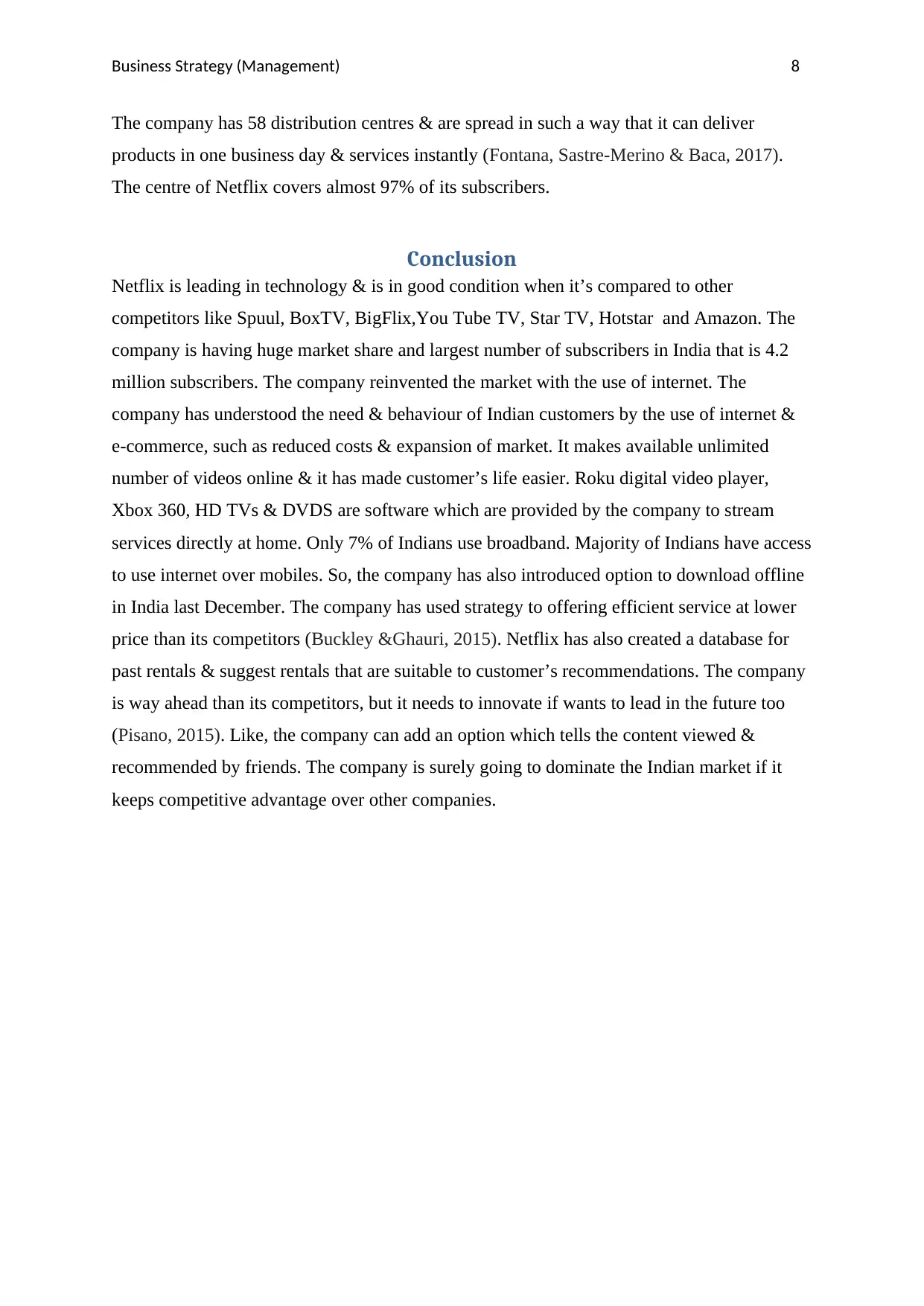
Business Strategy (Management) 8
The company has 58 distribution centres & are spread in such a way that it can deliver
products in one business day & services instantly (Fontana, Sastre-Merino & Baca, 2017).
The centre of Netflix covers almost 97% of its subscribers.
Conclusion
Netflix is leading in technology & is in good condition when it’s compared to other
competitors like Spuul, BoxTV, BigFlix,You Tube TV, Star TV, Hotstar and Amazon. The
company is having huge market share and largest number of subscribers in India that is 4.2
million subscribers. The company reinvented the market with the use of internet. The
company has understood the need & behaviour of Indian customers by the use of internet &
e-commerce, such as reduced costs & expansion of market. It makes available unlimited
number of videos online & it has made customer’s life easier. Roku digital video player,
Xbox 360, HD TVs & DVDS are software which are provided by the company to stream
services directly at home. Only 7% of Indians use broadband. Majority of Indians have access
to use internet over mobiles. So, the company has also introduced option to download offline
in India last December. The company has used strategy to offering efficient service at lower
price than its competitors (Buckley &Ghauri, 2015). Netflix has also created a database for
past rentals & suggest rentals that are suitable to customer’s recommendations. The company
is way ahead than its competitors, but it needs to innovate if wants to lead in the future too
(Pisano, 2015). Like, the company can add an option which tells the content viewed &
recommended by friends. The company is surely going to dominate the Indian market if it
keeps competitive advantage over other companies.
The company has 58 distribution centres & are spread in such a way that it can deliver
products in one business day & services instantly (Fontana, Sastre-Merino & Baca, 2017).
The centre of Netflix covers almost 97% of its subscribers.
Conclusion
Netflix is leading in technology & is in good condition when it’s compared to other
competitors like Spuul, BoxTV, BigFlix,You Tube TV, Star TV, Hotstar and Amazon. The
company is having huge market share and largest number of subscribers in India that is 4.2
million subscribers. The company reinvented the market with the use of internet. The
company has understood the need & behaviour of Indian customers by the use of internet &
e-commerce, such as reduced costs & expansion of market. It makes available unlimited
number of videos online & it has made customer’s life easier. Roku digital video player,
Xbox 360, HD TVs & DVDS are software which are provided by the company to stream
services directly at home. Only 7% of Indians use broadband. Majority of Indians have access
to use internet over mobiles. So, the company has also introduced option to download offline
in India last December. The company has used strategy to offering efficient service at lower
price than its competitors (Buckley &Ghauri, 2015). Netflix has also created a database for
past rentals & suggest rentals that are suitable to customer’s recommendations. The company
is way ahead than its competitors, but it needs to innovate if wants to lead in the future too
(Pisano, 2015). Like, the company can add an option which tells the content viewed &
recommended by friends. The company is surely going to dominate the Indian market if it
keeps competitive advantage over other companies.
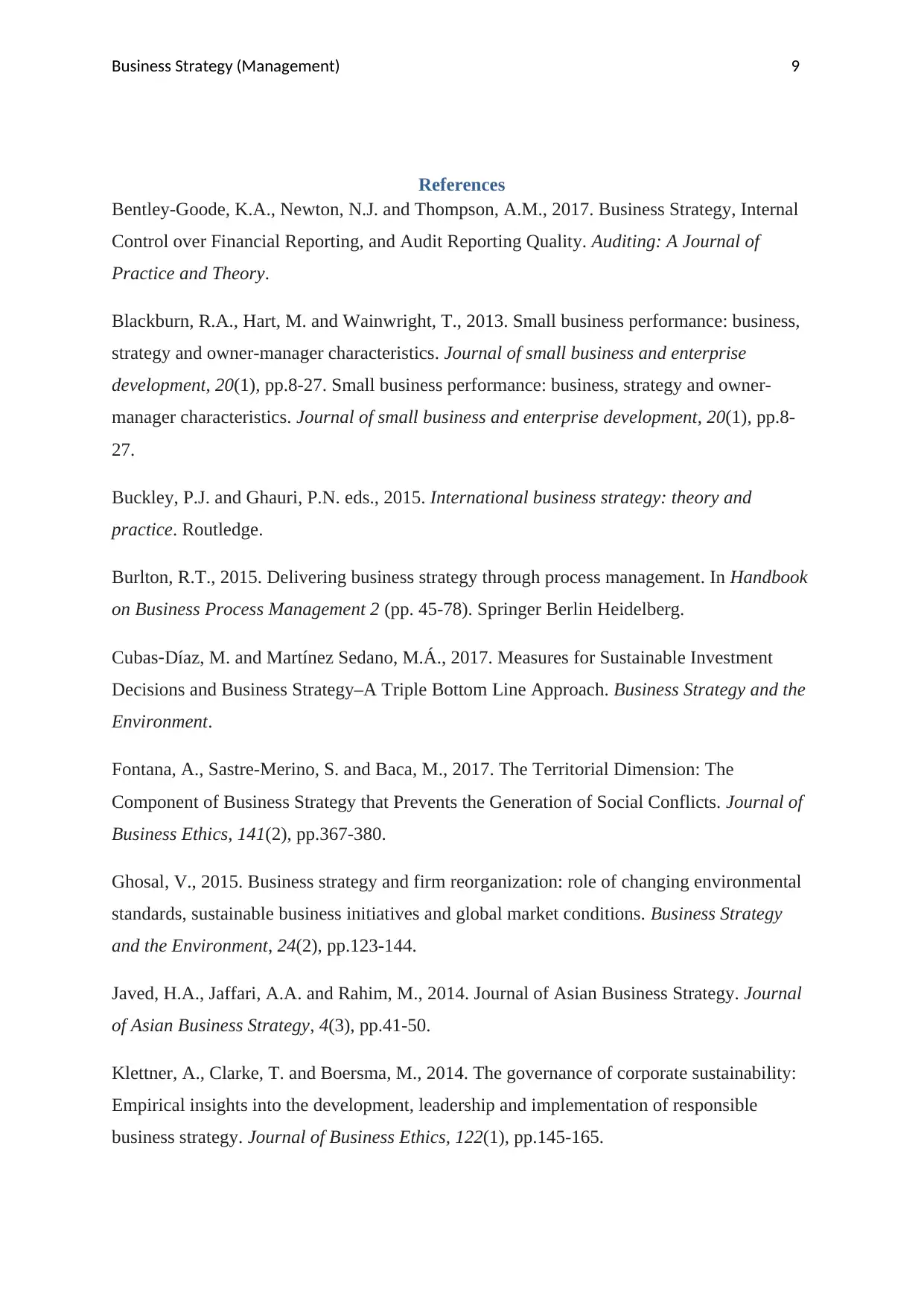
Business Strategy (Management) 9
References
Bentley-Goode, K.A., Newton, N.J. and Thompson, A.M., 2017. Business Strategy, Internal
Control over Financial Reporting, and Audit Reporting Quality. Auditing: A Journal of
Practice and Theory.
Blackburn, R.A., Hart, M. and Wainwright, T., 2013. Small business performance: business,
strategy and owner-manager characteristics. Journal of small business and enterprise
development, 20(1), pp.8-27. Small business performance: business, strategy and owner-
manager characteristics. Journal of small business and enterprise development, 20(1), pp.8-
27.
Buckley, P.J. and Ghauri, P.N. eds., 2015. International business strategy: theory and
practice. Routledge.
Burlton, R.T., 2015. Delivering business strategy through process management. In Handbook
on Business Process Management 2 (pp. 45-78). Springer Berlin Heidelberg.
Cubas‐Díaz, M. and Martínez Sedano, M.Á., 2017. Measures for Sustainable Investment
Decisions and Business Strategy–A Triple Bottom Line Approach. Business Strategy and the
Environment.
Fontana, A., Sastre-Merino, S. and Baca, M., 2017. The Territorial Dimension: The
Component of Business Strategy that Prevents the Generation of Social Conflicts. Journal of
Business Ethics, 141(2), pp.367-380.
Ghosal, V., 2015. Business strategy and firm reorganization: role of changing environmental
standards, sustainable business initiatives and global market conditions. Business Strategy
and the Environment, 24(2), pp.123-144.
Javed, H.A., Jaffari, A.A. and Rahim, M., 2014. Journal of Asian Business Strategy. Journal
of Asian Business Strategy, 4(3), pp.41-50.
Klettner, A., Clarke, T. and Boersma, M., 2014. The governance of corporate sustainability:
Empirical insights into the development, leadership and implementation of responsible
business strategy. Journal of Business Ethics, 122(1), pp.145-165.
References
Bentley-Goode, K.A., Newton, N.J. and Thompson, A.M., 2017. Business Strategy, Internal
Control over Financial Reporting, and Audit Reporting Quality. Auditing: A Journal of
Practice and Theory.
Blackburn, R.A., Hart, M. and Wainwright, T., 2013. Small business performance: business,
strategy and owner-manager characteristics. Journal of small business and enterprise
development, 20(1), pp.8-27. Small business performance: business, strategy and owner-
manager characteristics. Journal of small business and enterprise development, 20(1), pp.8-
27.
Buckley, P.J. and Ghauri, P.N. eds., 2015. International business strategy: theory and
practice. Routledge.
Burlton, R.T., 2015. Delivering business strategy through process management. In Handbook
on Business Process Management 2 (pp. 45-78). Springer Berlin Heidelberg.
Cubas‐Díaz, M. and Martínez Sedano, M.Á., 2017. Measures for Sustainable Investment
Decisions and Business Strategy–A Triple Bottom Line Approach. Business Strategy and the
Environment.
Fontana, A., Sastre-Merino, S. and Baca, M., 2017. The Territorial Dimension: The
Component of Business Strategy that Prevents the Generation of Social Conflicts. Journal of
Business Ethics, 141(2), pp.367-380.
Ghosal, V., 2015. Business strategy and firm reorganization: role of changing environmental
standards, sustainable business initiatives and global market conditions. Business Strategy
and the Environment, 24(2), pp.123-144.
Javed, H.A., Jaffari, A.A. and Rahim, M., 2014. Journal of Asian Business Strategy. Journal
of Asian Business Strategy, 4(3), pp.41-50.
Klettner, A., Clarke, T. and Boersma, M., 2014. The governance of corporate sustainability:
Empirical insights into the development, leadership and implementation of responsible
business strategy. Journal of Business Ethics, 122(1), pp.145-165.
Secure Best Marks with AI Grader
Need help grading? Try our AI Grader for instant feedback on your assignments.
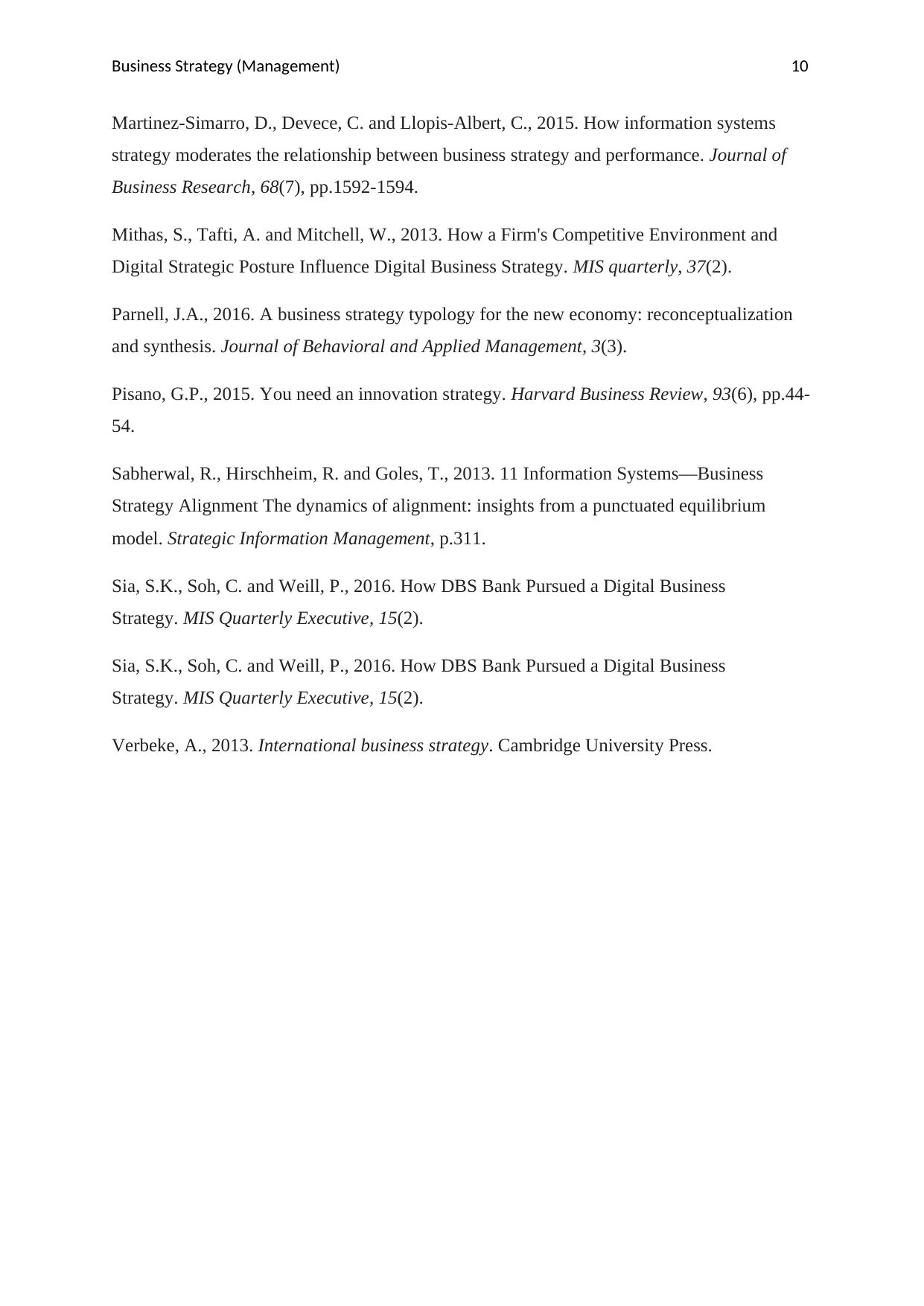
Business Strategy (Management) 10
Martinez-Simarro, D., Devece, C. and Llopis-Albert, C., 2015. How information systems
strategy moderates the relationship between business strategy and performance. Journal of
Business Research, 68(7), pp.1592-1594.
Mithas, S., Tafti, A. and Mitchell, W., 2013. How a Firm's Competitive Environment and
Digital Strategic Posture Influence Digital Business Strategy. MIS quarterly, 37(2).
Parnell, J.A., 2016. A business strategy typology for the new economy: reconceptualization
and synthesis. Journal of Behavioral and Applied Management, 3(3).
Pisano, G.P., 2015. You need an innovation strategy. Harvard Business Review, 93(6), pp.44-
54.
Sabherwal, R., Hirschheim, R. and Goles, T., 2013. 11 Information Systems—Business
Strategy Alignment The dynamics of alignment: insights from a punctuated equilibrium
model. Strategic Information Management, p.311.
Sia, S.K., Soh, C. and Weill, P., 2016. How DBS Bank Pursued a Digital Business
Strategy. MIS Quarterly Executive, 15(2).
Sia, S.K., Soh, C. and Weill, P., 2016. How DBS Bank Pursued a Digital Business
Strategy. MIS Quarterly Executive, 15(2).
Verbeke, A., 2013. International business strategy. Cambridge University Press.
Martinez-Simarro, D., Devece, C. and Llopis-Albert, C., 2015. How information systems
strategy moderates the relationship between business strategy and performance. Journal of
Business Research, 68(7), pp.1592-1594.
Mithas, S., Tafti, A. and Mitchell, W., 2013. How a Firm's Competitive Environment and
Digital Strategic Posture Influence Digital Business Strategy. MIS quarterly, 37(2).
Parnell, J.A., 2016. A business strategy typology for the new economy: reconceptualization
and synthesis. Journal of Behavioral and Applied Management, 3(3).
Pisano, G.P., 2015. You need an innovation strategy. Harvard Business Review, 93(6), pp.44-
54.
Sabherwal, R., Hirschheim, R. and Goles, T., 2013. 11 Information Systems—Business
Strategy Alignment The dynamics of alignment: insights from a punctuated equilibrium
model. Strategic Information Management, p.311.
Sia, S.K., Soh, C. and Weill, P., 2016. How DBS Bank Pursued a Digital Business
Strategy. MIS Quarterly Executive, 15(2).
Sia, S.K., Soh, C. and Weill, P., 2016. How DBS Bank Pursued a Digital Business
Strategy. MIS Quarterly Executive, 15(2).
Verbeke, A., 2013. International business strategy. Cambridge University Press.
1 out of 11
Related Documents
Your All-in-One AI-Powered Toolkit for Academic Success.
+13062052269
info@desklib.com
Available 24*7 on WhatsApp / Email
![[object Object]](/_next/static/media/star-bottom.7253800d.svg)
Unlock your academic potential
© 2024 | Zucol Services PVT LTD | All rights reserved.





